Is it allowed to stop at this place
Tickets SDA 2016—2017 online
1 question. What does the term "overrun" mean?
Correct answer: 1. The advance of one or more vehicles associated with the exit to the lane (side of the carriageway) intended for oncoming traffic, and the subsequent return to the previously occupied lane (side of the carriageway).
Explanation: According to the definition, c is a maneuver of advancing one or more moving vehicles, associated with the departure from the occupied lane to the oncoming lane.
2 question. This road sign warns:

Correct answer: 3. About approaching a section of the road where gravel (crushed stone) can be thrown out from under the wheels.
Explanation: The warning indicates that gravel or crushed stone can be thrown out from under the wheels of cars. Possible precautions should be taken.
3 question. Are you allowed to park your car at this location on even days of the month?

Correct answer: 1. Permitted.
Explanation: located with right side roads, and starts its action from the place of installation. Before the sign is allowed on any day of the month.
4 question. Which of the indicated signs inform that the requirements of the Rules that establish the order of movement in settlements apply on this road?

Correct answer: 2. A and B.
Explanation: All of the indicated signs have the same name “Beginning of a settlement”, but the requirements of the Rules establishing the order of movement in settlements are valid only “under” signs with a white background: A and B.
5 question. In this situation, you:

Correct answer: 2. Must stop at the stop line.
Explanation: road markings indicates the place where the driver is required to stop on request.
6 question. In which direction are you allowed to move?

Correct answer: 2. Straight, to the left and in the opposite direction.
Explanation: With the indicated position of the traffic controller, movement is allowed in all directions (). Your car is moving in the left lane, which means you are not allowed to turn right (). There are three other directions left: straight, left and back.
7 question. You intend to stop on the left at the sidewalk. When are you required to turn on your turn signals?

Correct answer: 3. In both cases listed.
Explanation: According to the driver, before starting to move, changing lanes, turning (turning) and stopping, he must signal with the direction indicators of the corresponding direction. Specified conditions listed in both cases.
8 question. You can continue driving:

Correct answer: 2. Along trajectories A or B.
Explanation: The crossed road has One Way() and its intersection in the forward direction is not prohibited. When turning right, you should move as close as possible to the right edge of the carriageway (), therefore, it is forbidden to turn along path B. There are two options left: A and B.
9 question. On what trajectory do you have the right to make a U-turn?

Correct answer: 2. Only at the intersection - along path A.
Clarification: The sign is valid until the nearest intersection and does not prohibit only turning right into the courtyard. U-turn along trajectory B in this case is prohibited. And at the intersection (along the trajectory A) you can turn around.
10 question. In which of the following cases is it allowed to drive in populated areas at a speed of no more than 20 km / h?

Correct answer: 3. In both.
Clarification: In residential areas and yard areas, pedestrians have the right to use both the sidewalk and carriageway, where they have an advantage over vehicles (item and). The speed of the vehicle in residential areas and in courtyard areas is limited to 20 km / h ().
Ticket 30 - Question 1
Which picture shows an intersection?
1. Only on the left.
2. Only on the right.
3. On both.
The intersection is shown only in the left figure, where a dirt road adjoins the paved road. Departures from adjacent territories (including from courtyards) are not intersections (clause 1.2).
Correct answer:
Only on the left.
Ticket 30 - Question 2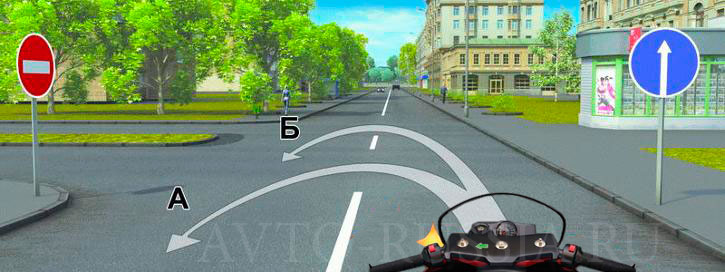
You can do a reversal:
1. Only along trajectory A.
2. Only along trajectory B.
3. On any trajectory from the specified ones.
The road adjacent to the left has two carriageways. Sign 4.1.1 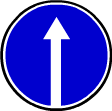 "Driving straight" acts only on the first intersection of the carriageways in front of which it is installed, prohibiting left turns and U-turns here. At the second intersection, there are no restrictions on maneuvers, so you can turn around here (trajectory B).
"Driving straight" acts only on the first intersection of the carriageways in front of which it is installed, prohibiting left turns and U-turns here. At the second intersection, there are no restrictions on maneuvers, so you can turn around here (trajectory B).
Correct answer:
Only on route B.
Ticket 30 - Question 3
Are you allowed to park your car at this location on odd days of the month?
1. Allowed.
2. Allowed only after 19 hours.
Correct answer:
Only to the right.
Ticket 30 - Question 7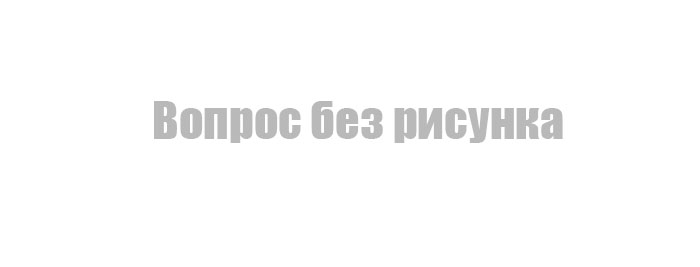
What should I do when making a left turn on a two-lane road?
1. Start the maneuver, simultaneously turning on the left turn indicators.
2. Turn on the left turn indicators, then proceed to the maneuver.
3. Make sure that the maneuver is safe, then turn on the left turn indicators and proceed to the maneuver.
Before turning left or making a U-turn, it is required to turn on the light signals for the left turn (clause 8.1). However, before you give a signal, you should make sure that your maneuver is safe, first of all, that no one is overtaking you. It is necessary to do this, since the Rules prohibit preventing overtaking by increasing speed or other actions (clause 11.3).
Correct answer:
Make sure that the maneuver is safe, then turn on the left turn indicators and proceed with the maneuver.
Ticket 30 - Question 8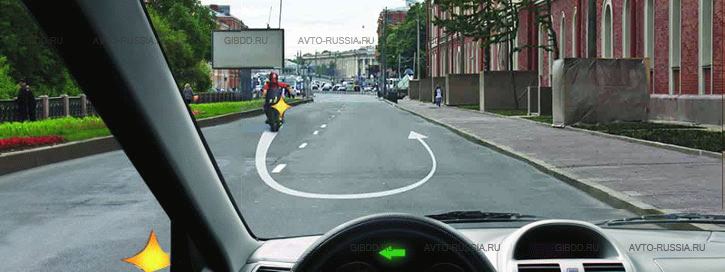
You intend to start from the sidewalk. Should you give way to a motorcycle turning around?
1. Must.
2. You shouldn't if you are driving a passenger taxi.
3. Shouldn't.
Before starting off the pavement, you must make sure that you do not endanger traffic or interfere with other participants. traffic. Therefore, you must give way to a motorcycle making a U-turn (section 8.1).
Correct answer:
Should.
Ticket 30 - Question 9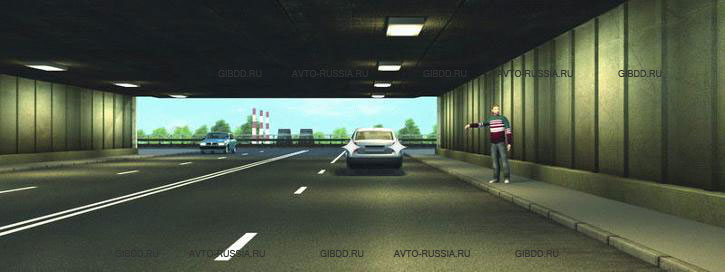
Is the driver of a car allowed to drive in reverse to board a passenger in a tunnel?
1. Allowed.
2. Permitted, if this does not interfere with other road users.
Correct answer:
Forbidden.
Ticket 30 - Question 10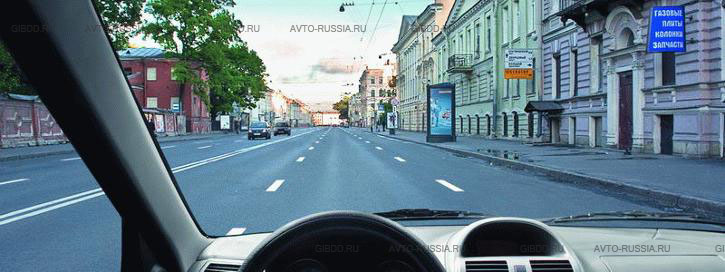
In this situation, you are allowed to move:
1. Only on the right lane.
2. On the right or middle lane.
3. On any lane.
On a free road located in locality and having three traffic lanes in this direction, you are allowed to move in any lane, except for the left one (clause 9.4).
Correct answer:
On the right or middle lane.
Ticket 30 - Question 11
Is it legal to overtake in a tunnel?
1. Allowed.
2. Permitted only in the presence of artificial lighting.
Taking into account the increased danger of passage of artificial structures on the roads, the Rules prohibit overtaking on bridges, overpasses, overpasses and under them, as well as in tunnels (clause 11.4).
Correct answer:
Forbidden.
Ticket 30 - Question 12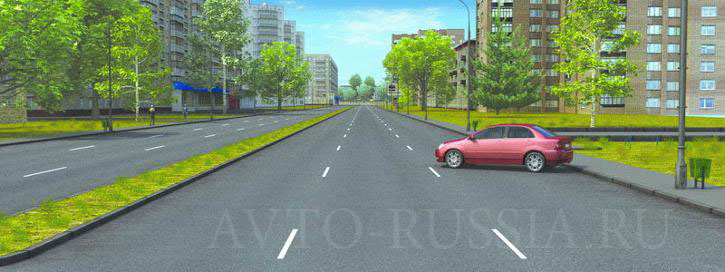
Is it possible for the driver to park the car in the specified way?
2. It is possible, if this does not interfere with the movement of other vehicles.
3. You can't.
Parking the car at an angle to the edge of the carriageway is permitted only where there is a corresponding widening of the carriageway. In other places, the driver is obliged to park the car parallel to the edge of the carriageway (clause 12.2).
Correct answer:
It is forbidden.
Ticket 30 - Question 13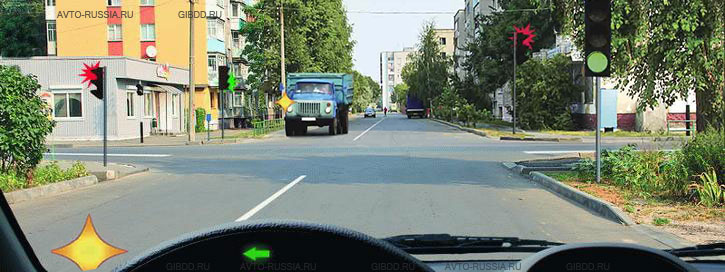
When do you have to give way truck?
1. When turning left.
2. When turning.
When turning left or making a U-turn at the permissive signal of a traffic light, you must give way to an oncoming truck turning right (clause 13.4).
Correct answer:
Ticket 30 - Question 14![]()
You intend to continue straight ahead with a flashing yellow traffic light. Your actions?
1. Stop and continue driving only after the traffic light turns green.
2. Give way to the horse-drawn cart.
3. Pass the intersection first with the oncoming vehicle.
With a yellow flashing traffic light, the intersection is considered unregulated (clause 13.3), so you must, guided by the rules for passing the intersections of equivalent roads, give way to a horse-drawn cart approaching from the right (clause 13.11).
Correct answer:
Give way to the horse-drawn cart.
Ticket 30 - Question 15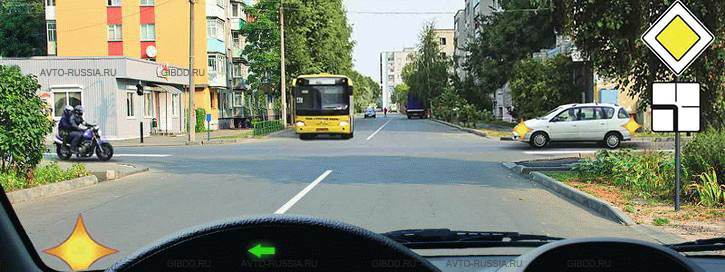
You intend to turn left. To whom do you have to give way?
1. Passenger car and bus.
2. Only by bus.
3. Motorcycle only.
4. Nobody.
Passing this intersection of unequal roads in the direction of the main road (signs 2.1 "Main road" and 8.13  “Direction of the main road”), you have an advantage not only over the bus and car located on the secondary road (clause 13.9), but also over the motorcycle, which, like you, moves along main road and for which you are a "hindrance on the right" (clauses 13.10 and 13.11).
“Direction of the main road”), you have an advantage not only over the bus and car located on the secondary road (clause 13.9), but also over the motorcycle, which, like you, moves along main road and for which you are a "hindrance on the right" (clauses 13.10 and 13.11).
Correct answer:
Nobody.
Ticket 30 - Question 16
In what case is the driver of a vehicle approaching an unregulated pedestrian crossing required to give way to pedestrians?
1. If pedestrians cross the road.
2. If pedestrians have entered the carriageway (tram tracks) to make the transition.
3. In both listed cases.
The driver of a vehicle approaching an unregulated pedestrian crossing is obliged to give way to pedestrians crossing the road or entering the carriageway (tram tracks) to make the crossing (clause 14.1).
Correct answer:
In both cases listed.
Ticket 30 - Question 17
1. Permitted, if this does not interfere with the movement of route vehicles.
2. Allowed.
Forbidden.
Comment: The driver violated the parking rule, as the rules prohibit parking on pedestrian crossing and closer than 5 meters to it.
Question 13.
Pass the intersection first.
2. Wait for the permission signal of a special traffic light and only then turn.
3. Give way to the tram.
Comment: The combination of a green traffic light and an on arrow in the additional section allows you to turn left (clause 6.2). The traffic of the tram at this intersection is regulated by a traffic light of a single-color signaling in the form of the letter "T". Considering that tram traffic is prohibited at such a signal (clause 6.8), you can pass the intersection first.
Question 14.
You intend to turn left. Your actions?
1. Pass the intersection without giving way to pedestrians.
Give way to pedestrians.
Comment: When turning left at this intersection, you should give way to pedestrians crossing the carriageway of the road you are turning into, since when turning right or left, the driver must give way to pedestrians crossing the carriageway to which he is turning, as well as to cyclists crossing it along the bike path.
Question 15.
You intend to drive straight through the intersection. Your actions?
1. Pass the intersection first.
Give way to a vehicle with a rotating beacon and a special sound signal.
Comment: When approaching a vehicle with a flashing beacon on of blue color and a special sound signal, drivers are obliged to give way to ensure the unhindered passage of the specified vehicle.
Question 16.
When approaching a stopped vehicle with the alarm, which has identification marks"Transportation of children", the driver must:
1. Reduce speed
2. If necessary, stop and let the children pass
Carry out all of the above
Comment: Approaching a stopped vehicle with the alarm turned on and having the identification marks "Transportation of children", the driver must slow down and, if necessary, stop and let the children pass (paragraph 14.7 of the SDA).
Question 17.
Daytime running lights are designed for:
1. Improving the visibility of a moving vehicle during daylight hours only from behind.
Improving the visibility of a moving vehicle during daylight hours only from the front.
3. Improving the visibility of a moving vehicle during daylight hours both in front and behind.
Comment: This definition just needs to be remembered. "Daytime running lights" - external lighting devices designed to improve the visibility of a moving vehicle in front during daylight hours.
Question 18.
You have the right to operate a passenger car in the absence of:
1. Fire extinguisher.
2. Emergency stop sign.
3. First aid kits.
Anti-recoil stops.
Comment: Absence on passenger car wheel chocks is not a basis for prohibiting its operation.
Question 19.
To ensure safety when stopping on an uphill (downhill), the driver should turn the front wheels. Which vehicle drivers correctly complied with this requirement in the absence of a sidewalk?





